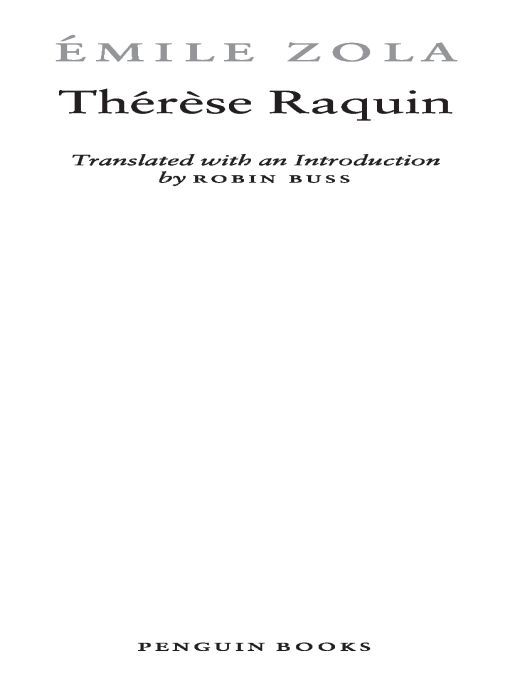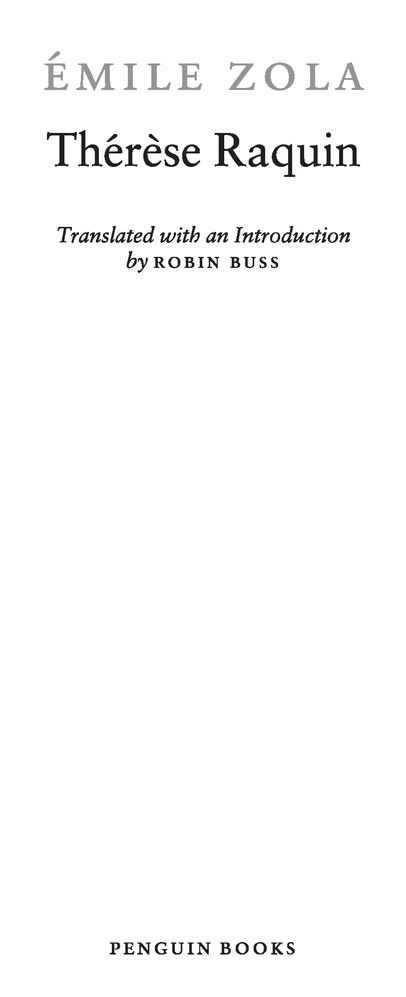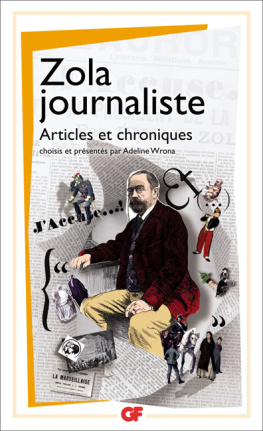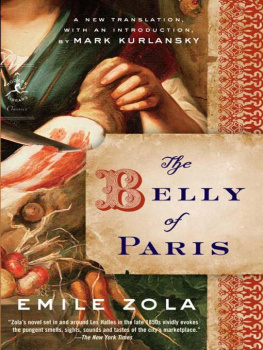Table of Contents
THRSE RAQUIN
MILE ZOLA, born in Paris in 1840, was brought up in Aix-en-Provence in an atmosphere of struggling poverty after the death of his father in 1847. He was educated at the College Bourbon at Aix and then at the Lyce Saint-Louis in Paris. After failing the baccalaurat twice and then taking menial clerical employment, he joined the newly founded publishing house Hachette in 1862. and quickly rose to become head of publicity. Having published his first novel in 1865 he left Hachette the following year to become a full-time journalist and writer. Thrse Raquin appeared in 1867 and caused a scandal, to which he responded with his famous Preface to the novels second edition in 1868 in which he laid claim to being a Naturalist. That same year he began work on a series of novels intended to trace scientifically the effects of heredity and environment in one family: Les Rougon-Macquart. This great cycle eventually contained twenty novels, which appeared between 1871 and 1893. In 1877 the seventh of these, LAssommoir (The Drinking Den), a study of alcoholism in working-class Paris, brought him abiding wealth and fame. On completion of the Rougon-Macquart series he began a new cycle of novels, Les Trois Villes: Lourdes, Rome, Paris (1894-8), a violent attack on the Church of Rome, which led to another cycle, Les Quatre vangiles. While his later writing was less successful, he remained a celebrated figure on account of the Dreyfus case, in which his powerful interventions played an important part in redressing a heinous miscarriage of justice. His marriage in 1870 had remained childless, but his happy, public relationship in later life with Jeanne Rozerot, initially one of his domestic servants, brought him a son and a daughter. He died in mysterious circumstances in 1902., the victim of an accident or murder.
ROBIN BUSS is a writer and translator who works as a freelance journalist and as television critic for The Times Educational Supplement. He studied at the University of Paris, where he took a degree and doctorate in French literature. He is part-author of the article French Literature in Encyclopaedia Britannica and has published critical studies of works by Vigny and Cocteau, and three books on European cinema, The French through Their Films (1988), Italian Films (1989) and French Film Noir (1994). He has translated a number of other volumes for Penguin, including mile Zolas LAssommoir and Au Bonheur des Dames.
Introduction
(New readers are advised that this Introduction makes
the details of the plot explicit.)
Thrse Raquin is the only one of mile Zolas works outside his novel-cycle Les Rougon-Macquart and his polemic JAccuse that is widely read. Indeed, with a few individual works from that twenty-volume cycle, it represents the height of his achievement as a novelist. Published in 1867, when Zola was only twenty-seven, it was not his first work of fiction, but it is the book that established his reputation as one of the outstanding novelists of the younger generation. Denounced by the critic of Le Figaro as putrid, a pool of filth and blood,
The novel does, however, differ from the later works in some important respects. Les Rougon-Macquart was a hugely ambitious project, designed (according to its subtitle) to constitute The Natural and Social History of a Family under the Second Empire. The individual volumes in the cycle centre on a particular aspect of life in that period: provincial and national politics (La Fortune des Rougon, Son Excellence Eugne Rougon); the Parisian working class (Le Ventre de Paris, LAssommoir); the industrial working class (Germinal); the peasantry (La Terre); and so on. Entering into these different milieux is part of the pleasure of reading Zola, and he supported the fictional narrative with extensive documentary research into life in a large department store, for example, when writing Au Bonheur des Dames, or among workers on the railway, for La Bte humaine. Behind the chief protagonists in all these novels, one is aware of a host of minor figures and, beyond them, of the crowd: the crowd in the Parisian streets and markets, the shoppers in the department store, the miners, politicians, priests, soldiers, stockbrokers, workers and peasants who populate the background of the picture.
This is not the case in Thrse Raquin. Here is a tale of adultery, murder and madness, set mainly in a single location and with a cast of four leading characters and four minor ones (five, if we count the cat, Franois). Only during the scenes on the river (Chapters XI and XII) and in the Morgue (Chapter XIII) does one have any sense of other people moving around in the background; only very exceptionally does the writer introduce another character with a speaking part, like the painter who makes a fleeting appearance in Chapter XXV. For the rest of the time, he concentrates our attention on Thrse, Camille, Laurent and Madame Raquin, with occasional appearances by the group of guests who visit them every Thursday: Grivet, the Michauds, father and son, the sons wife, Suzanne; and, of course, by the cat. In the forefront of this picture is Thrse, the half-Arab orphan who is abandoned by her father to be brought up by her aunt, the haberdasher, Madame Raquin. Thrse has to compete for her aunts affections with her cousin, Madame Raquins sickly son, Camille. It is an uneven struggle. Camille gets all the attention, while Thrse learns to hold in her frustration and resentment, her natural energy and health smothered by the possessive mother and feeble son. When the time comes, she accepts marriage to Camille for want of anything better and prepares for a life of endless Thursday evenings playing dominoes in the company of Madame Raquins friends: the former policeman, Michaud, and his son, and the railway clerk, Grivet. The stage is set for a tragedy that will be set off by the arrival of Camilles friend Laurent, a sturdy lad, self-indulgent and unscrupulous, who releases the full force of Thrses passionate nature under the watchful eye of Franois, the cat.
The novel is intentionally claustrophobic. Thrse Raquin is a chamber piece, a melodrama, a horror story about two murderers who descend into madness, haunted by the shade of their victim and observed eventually by a paralysed woman, who cannot move or speak, but has to listen and watch as they disintegrate in front of her. We are meant to share her feeling of powerlessness and revulsion. We are fascinated spectators of what happens to Thrse and Laurent, alongside the stricken Madame Raquin and the equally mute and eloquent cat.
The significance of the cat can be overestimated. After all, the beast does little in the book except what cats do in real life. It hangs around and watches quietly, as its human owners get on with their lives. But Laurent, in his folly, attributes to the cat supernatural powers of understanding and judgement: when he and Thrse start their affair, the cat seems to be watching them with disapproval; after the murder, it seems to know what has happened to Camille. Perhaps we make a mistake similar to Laurents when we think that the cat plays a significant role in the novel. Perhaps the animal is purely for decoration, but few critics would think so. They have often compared Franois to the cat in Manets painting












